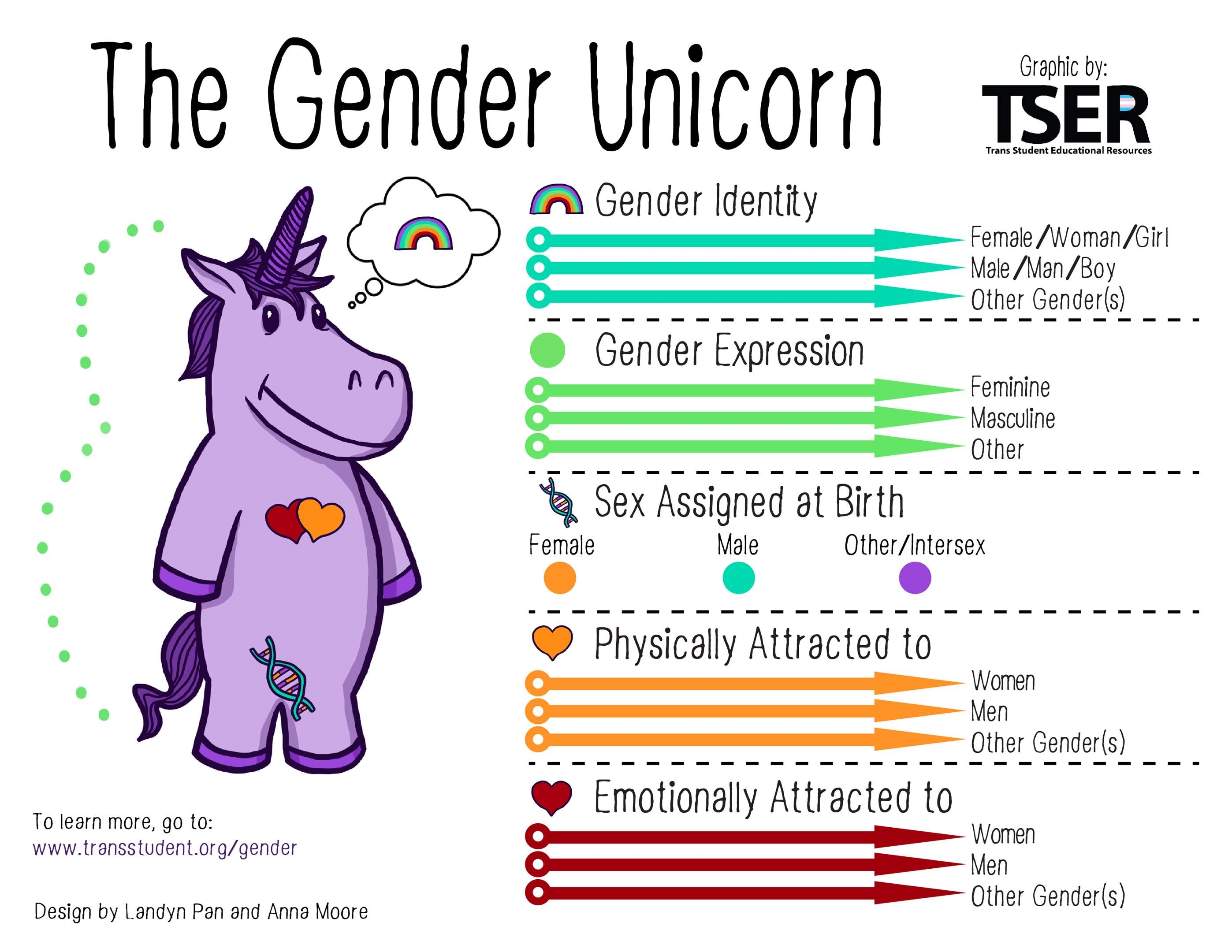4. Defining Gender
Defining Gender
The goal of this section is to provide some helpful definitions around terms that are often used when discussing gender and identity. This section is not intended to create limiting divides or narrowed understandings of gender.
Before discussing how to address gender inequity in STEM it is important to note that we are working from a common understanding of gender. Gender is a concept that is commonly misunderstood. Often, gender is conflated with assigned sex, a “M” or “F” signifier that was assigned at birth, based most often on a visual assessment of external biological traits. In reality, gender is a much more complex aspect of human identity. Individuals identify across a spectrum of gender identities.
The illustration and definitions below are a helpful introductory tool for understanding the different concepts associated with gender.
For more information or to explore these ideas further, check out the following sites: https://transstudent.org/gender/ and www.genderbread.org.

Gender Identity: is who you, in your head, know yourself to be and how you define your gender.
Gender Expression: is how you present gender (through actions, clothing, demeanour, etc.) and how these presentations are viewed through social expectations (e.g., are the clothes you choose to wear considered feminine or masculine in your societal context?).
Sex Assigned at Birth: refers to the initial categorization of an individual's sex based on the observable primary sexual characteristics at the time of birth. It's important to note that the sex assigned at birth may not align with an individual's biological sex. As elucidated by Trans Student Educational Resources (n.d.), the assignment and classification of people into categories such as male, female, intersex, or another sex result from a combination of factors, including anatomy, hormones, and chromosomes. It's worth highlighting that chromosomes are commonly utilized in determining sex; however, they do not invariably dictate genitalia, sex, or gender. This acknowledgment underscores the complexity and nuances involved in understanding and defining an individual's sex beyond the initial assignment at birth.
Attraction: is how you find yourself romantically/sexually/physically drawn to (or not drawn to) other people.
Transgender: someone whose gender identity and/or expression does not align with the sex they were assigned at birth.
Cisgender: someone whose gender identity aligns with their assigned sex at birth.
Non-binary: “An adjective describing a person who does not identify exclusively as a man or a woman. Non-binary people may identify as being both a man and a woman, somewhere in between, or as falling completely outside these categories. While many also identify as transgender, not all non-binary people do. Non-binary can also be used as an umbrella term encompassing identities such as agender, bigender, genderqueer or gender-fluid” (Human Rights Campaign, n.d.).
Goals of Gender Equitable Programming
The goal of gender-equitable programming is to create and deliver programming that is accessible and inclusive of all genders. In order to achieve this, programming must include youth of any gender, and all-girl programs must be inclusive of participants who identify as a girl (or a trans identity that aligns with girls programming). To be clear, all-girl camps and clubs must welcome trans and any other youth that may identify with a girls’ program. This, as well as information about how to create inclusive learning environments for all genders, will be explored further at the end of this module.
Every experience is different
We’d like to introduce you to Sam. Please explore their story: Sam's Story
As stated by Gender Creative Kids Canada:
Even though everyone does not experience the steps in the same way, all children explore their gender identity and their gender expression in unique ways. Sometimes the gender identity we feel inside corresponds to the identity that was assigned to us at birth. Some other times, the identity we feel inside is different from what was assigned to us at birth. Questioning and understanding our identity is an important step in the life of every human being. It is very important to have friends or relatives around us who love us and who understand us so that we can confide in them and express who we truly are without fearing the consequences. (p. 82)
Reflection Questions
- Why might it be important to consider youth like Sam in our programming?
- How can we ensure that all youth feel welcome in our programming?
Canadian Stats
Canada is the first country to collect and publish data on gender diversity from a national census. Of the nearly 30.5 million people in Canada aged 15 and older living in a private household in May 2021, 100,815 were transgender (59,460) or non-binary (41,355), accounting for 0.33% of the population in this age group.
As stated in the table below, the proportions of transgender and non-binary people were three to seven times higher for Generation Z (born between 1997 and 2006, 0.79%) and millennials (born between 1981 and 1996, 0.51%) than for Generation X (born between 1966 and 1980, 0.19%), baby boomers (born between 1946 and 1965, 0.15%) and the Interwar and Greatest Generations (born in 1945 or earlier, 0.12%).
Generation | Percentage of trans identifying people |
Generation Z (1997-2006) | 0.79% |
Millennials (1981-1996) | 0.51% |
Generation X (1966-1980) | 0.19% |
Baby Boomers (1946-1965) | 0.15% |
Interwar & Greatest Generations (born in 1945 or earlier) | 0.12% |
Over time, the acceptance and understanding of gender and sexual diversity has evolved. Further, there has been social and legislative recognition of transgender, non-binary and LGBTQ2+ people in general. Younger generations may be more comfortable reporting their gender identity than older generations, hence a shift in the numbers.
Gender Equity
- Getting Started
- 1. Introduction
- 2. Girls and Women* in STEM
- 3. Unconscious Bias
- 4. Defining Gender
- 5. Equity and Equality
- 6. Creating Gender Equity Across All Programming
- 7. Actua’s National Girls Program and Gender Parit…
- 8. Case Study
- 9. Summary and Reflection
- Survey
- Credits, References and Resources
Viewed 4,712 times